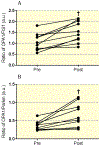Exercise training remodels human skeletal muscle mitochondrial fission and fusion machinery towards a pro-elongation phenotype
- PMID: 30408342
- PMCID: PMC6416060
- DOI: 10.1111/apha.13216
Exercise training remodels human skeletal muscle mitochondrial fission and fusion machinery towards a pro-elongation phenotype
Abstract
Aims: Mitochondria exist as a morphologically plastic network driven by cellular bioenergetic demand. Induction of fusion and fission machinery allows the organelle to regulate quality control and substrate flux. Physiological stressors promote fragmentation of the mitochondrial network, a process implicated in the onset of metabolic disease, including type 2 diabetes and obesity. It is well-known that exercise training improves skeletal muscle mitochondrial volume, number, and density. However, the effect of exercise training on muscle mitochondrial dynamics remains unclear.
Methods: Ten sedentary adults (65.8 ± 4.6 years; 34.3 ± 2.4 kg/m2 ) underwent 12 weeks of supervised aerobic exercise training (5 day/wk, 85% of HRMAX ). Body composition, cardio-metabolic testing, hyperinsulinaemic-euglycaemic clamps, and skeletal muscle biopsies were performed before and after training. MFN1, MFN2, OPA1, OMA1, FIS1, Parkin, PGC-1α, and HSC70 protein expression was assessed via Western blot.
Results: Exercise training led to improvements in insulin sensitivity, aerobic capacity, and fat oxidation (all P < 0.01), as well as reductions in body weight, BMI, fat mass and fasting glucose (all P < 0.001). When normalized for changes in mitochondrial content, exercise reduced skeletal muscle FIS1 and Parkin (P < 0.05), while having no significant effect on MFN1, MFN2, OPA1, and OMA1 expression. Exercise also improved the ratio of fusion to fission proteins (P < 0.05), which positively correlated with improvements in glucose disposal (r2 = 0.59, P < 0.05).
Conclusions: Exercise training alters the expression of mitochondrial fusion and fission proteins, promoting a more fused, tubular network. These changes may contribute to the improvements in insulin sensitivity and substrate utilization that are observed after exercise training.
Keywords: exercise training; insulin resistance; mitochondrial dynamics; obesity; skeletal muscle.
© 2018 Scandinavian Physiological Society. Published by John Wiley & Sons Ltd.
Conflict of interest statement
CONFLICT OF INTEREST
None of the authors have a conflict of interest related to this work.
Figures



Similar articles
-
Exercise training decreases activation of the mitochondrial fission protein dynamin-related protein-1 in insulin-resistant human skeletal muscle.J Appl Physiol (1985). 2014 Aug 1;117(3):239-45. doi: 10.1152/japplphysiol.01064.2013. Epub 2014 Jun 19. J Appl Physiol (1985). 2014. PMID: 24947026 Free PMC article.
-
High-intensity aerobic, but not resistance or combined, exercise training improves both cardiometabolic health and skeletal muscle mitochondrial dynamics.J Appl Physiol (1985). 2023 Oct 1;135(4):763-774. doi: 10.1152/japplphysiol.00405.2023. Epub 2023 Aug 24. J Appl Physiol (1985). 2023. PMID: 37616334 Free PMC article.
-
Human skeletal muscle mitochondrial dynamics in relation to oxidative capacity and insulin sensitivity.Diabetologia. 2021 Feb;64(2):424-436. doi: 10.1007/s00125-020-05335-w. Epub 2020 Nov 30. Diabetologia. 2021. PMID: 33258025 Free PMC article.
-
Endurance Exercise and the Regulation of Skeletal Muscle Metabolism.Prog Mol Biol Transl Sci. 2015;135:129-51. doi: 10.1016/bs.pmbts.2015.07.016. Epub 2015 Sep 5. Prog Mol Biol Transl Sci. 2015. PMID: 26477913 Review.
-
Insulin resistance with aging: effects of diet and exercise.Sports Med. 2000 Nov;30(5):327-46. doi: 10.2165/00007256-200030050-00002. Sports Med. 2000. PMID: 11103847 Review.
Cited by
-
Targeting skeletal muscle mitochondrial health in obesity.Clin Sci (Lond). 2022 Jul 29;136(14):1081-1110. doi: 10.1042/CS20210506. Clin Sci (Lond). 2022. PMID: 35892309 Free PMC article. Review.
-
Twenty-four hour rhythmicity in mitochondrial network connectivity and mitochondrial respiration; a study in human skeletal muscle biopsies of young lean and older individuals with obesity.Mol Metab. 2023 Jun;72:101727. doi: 10.1016/j.molmet.2023.101727. Epub 2023 Apr 14. Mol Metab. 2023. PMID: 37062525 Free PMC article.
-
Investigating the Pathogenesis and Treatment of Type 2 Diabetes from the Perspective of Adipose Tissue.Diabetes Metab Syndr Obes. 2025 Jul 14;18:2343-2360. doi: 10.2147/DMSO.S524000. eCollection 2025. Diabetes Metab Syndr Obes. 2025. PMID: 40687905 Free PMC article. Review.
-
UCC118 supplementation reduces exercise-induced gastrointestinal permeability and remodels the gut microbiome in healthy humans.Physiol Rep. 2019 Nov;7(22):e14276. doi: 10.14814/phy2.14276. Physiol Rep. 2019. PMID: 31758610 Free PMC article. Clinical Trial.
-
The mitochondrial profile in women with polycystic ovary syndrome: impact of exercise.J Mol Endocrinol. 2022 Mar 1;68(3):R11-R23. doi: 10.1530/JME-21-0177. J Mol Endocrinol. 2022. PMID: 35060480 Free PMC article. Review.
References
-
- American Diabetes A. Diagnosis and classification of diabetes mellitus. Diabetes Care. 2014;37 Suppl 1:S81–90. - PubMed
-
- Bugianesi E, Gastaldelli A, Vanni E, et al. Insulin resistance in non-diabetic patients with non-alcoholic fatty liver disease: sites and mechanisms. Diabetologia. 2005;48(4):634–642. - PubMed
-
- Corbould A, Kim YB, Youngren JF, et al. Insulin resistance in the skeletal muscle of women with PCOS involves intrinsic and acquired defects in insulin signaling. Am J Physiol Endocrinol Metab. 2005;288(5):E1047–1054. - PubMed
-
- DeFronzo RA, Ferrannini E. Insulin resistance. A multifaceted syndrome responsible for NIDDM, obesity, hypertension, dyslipidemia, and atherosclerotic cardiovascular disease. Diabetes Care. 1991;14(3):173–194. - PubMed
Publication types
MeSH terms
Grants and funding
LinkOut - more resources
Full Text Sources
Medical
Miscellaneous

